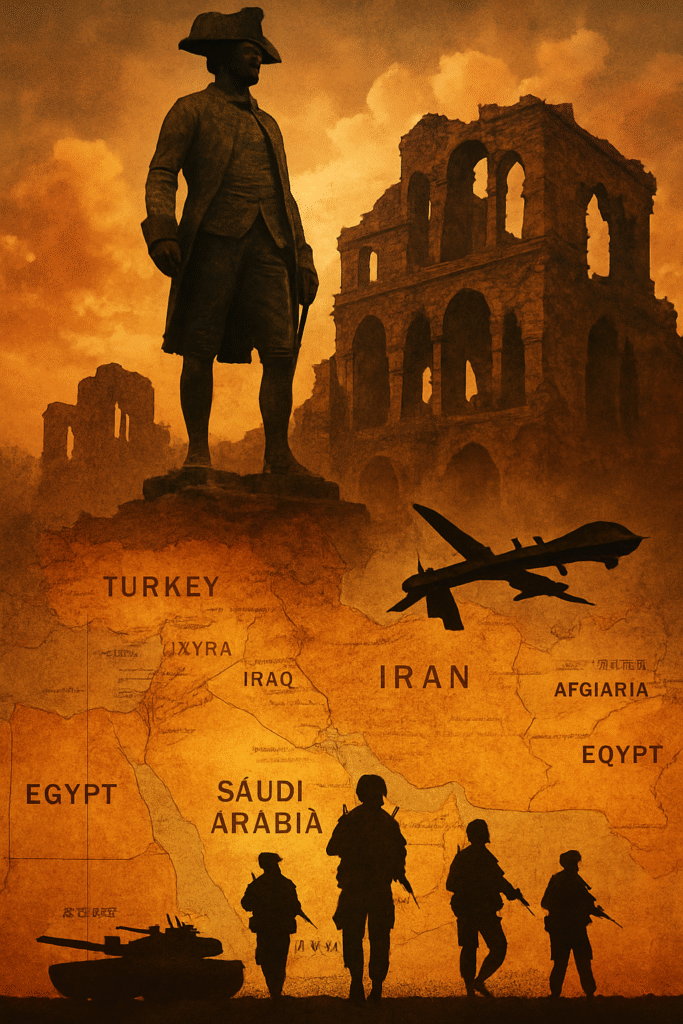
The current instability in the Middle East cannot be fully understood without tracing its roots to the late Ottoman period and the subsequent impact of European colonialism. As Jumana Bayeh (2021) rightly argues, any attempt to interpret the region’s chaotic trajectory without beginning from the decline of the Ottoman Empire is bound to be incomplete. The region’s collapse into disorder over the past two centuries is not accidental; it is the outcome of deliberate restructuring by external powers, initially through colonial domination and today through new forms of geopolitical competition.
The Colonial Disruption of the Ottoman World
At its peak, the Ottoman Empire was a formidable geopolitical structure that rivalled Europe in both military and economic strength. With its multinational, multi-religious system organised under the Millet framework, the Empire ensured a sense of unity without forcibly homogenising its subjects. Ethnic identities were subordinated to a larger imperial identity — Ottomanism. Economically, a centralised tax and trade system routed wealth to Istanbul, maintaining regional integration and state power (Bayeh, 2021).
However, the rise of European imperialism in the 19th century shattered this system. European powers not only redrew trade routes but also established financial dominance through loans and debt mechanisms. As Endelman (2018, p.824) notes, this indebtedness made Middle Eastern states dependent on European capitalist firms and financial institutions. Infrastructure projects, which ostensibly modernised the region, in fact restructured its economy to serve European interests.
Furthermore, colonialism imported European ideas of nationalism into a context previously governed by pluralism. The rise of Zionism, pan-Arabism, and Turkish nationalism eroded loyalty to the Ottoman state, destabilising its core identity. Once the cohesive Ottoman polity collapsed, European powers filled the vacuum by carving up the region through the Sykes-Picot Agreement, the Balfour Declaration, and colonial mandates — into fragmented, artificial states.
From Colonial Mandates to Dependent States
By the mid-20th century, most of the Arab world had been absorbed into the global capitalist system as peripheral economies (Amin, 1978, p.24). The bourgeoisie that emerged was not the product of a capitalist revolution but of imperial co-optation. This created what Amin termed a “half-capitalist, half-pre-capitalist” agrarian bourgeoisie — a hybrid class structure unlike Europe’s. Class struggle in the Arab world, then, took a different shape: not between proletariat and capitalist, but between colonial-backed elites and the dispossessed masses.
This hybrid economic system led to uneven development across the region. Post-independence states were formally sovereign but economically and militarily dependent. Many of these states adopted authoritarian models to maintain control, often backed by either the United States or the Soviet Union during the Cold War. These regimes suppressed internal dissent but failed to build sustainable development or regional stability.
The Post-Colonial Continuation: A New Great Game
The legacy of colonialism did not end with the withdrawal of French and British forces. Instead, it morphed into new forms of hegemony. The United States became the dominant external power in the Middle East after 1950, often manipulating sectarian, ethnic, or class divisions to maintain control. The 2003 invasion of Iraq, the ongoing occupation of Palestine, and support for authoritarian allies such as Saudi Arabia and Egypt are just a few examples.
More recently, a new multipolar contest has emerged. The United States and the European Union are now contending with rising influence from Russia and China. The rivalry between these powers echoes the colonial-era struggle for influence over Middle Eastern territories.
• Russia, weakened by Western sanctions and its prolonged war in Ukraine, has treated its Middle Eastern influence as a bargaining chip. Moscow has used its military presence in Syria and relations with Iran and Türkiye to gain leverage against NATO, often using Ukraine’s fate as a negotiating tool ([see Foreign Policy, 2024]).
• China, in contrast, has expanded its influence more subtly. Through the Belt and Road Initiative and strategic investments in energy, ports, and infrastructure across the Gulf and the Levant, Beijing has positioned itself as an economic partner without overt military intervention. However, China’s engagement with the region is not neutral; it views Middle Eastern alignment as part of its global strategy, especially as it faces off against the U.S. over Taiwan ([source: CSIS, 2024]).
• Türkiye, once envisioned as a bridge between East and West, now finds itself isolated. Its failed Syria policy, dependence on Russian energy, strained NATO relations, and the domestic costs of hosting four million Syrian refugees have pushed it into a precarious position. As noted in recent analysis ([Gönül Tol, Foreign Affairs, 2025]), Turkish foreign policy in Syria has served more to reinforce domestic political goals than regional stability, alienating both allies and adversaries.
Colonial Legacies and Modern Fragmentation
The effects of colonialism are not only historical — they continue to manifest in the region’s uneven development. Artificial borders created during the mandate period (e.g. between Iraq and Syria) have proven incapable of containing transnational identities and movements. The Israeli-Palestinian conflict remains unresolved, in part because of the British-backed foundation of a settler-colonial state. Sectarian tensions in Lebanon, Iraq, and Bahrain are exacerbated by the post-colonial state structure’s failure to accommodate pluralism.
Moreover, economic dependency has continued. Oil-rich states like Saudi Arabia and the UAE are heavily tied to Western capital and arms markets. Meanwhile, countries like Lebanon and Egypt face debt crises and IMF austerity programs. In both cases, the core-periphery relationship first established under colonialism has endured, leaving the region vulnerable to external shocks.
Orientalism vs. Class Analysis
Edward Said’s Orientalism exposed how Western representations of the Middle East shaped imperial policy and justified intervention. However, some scholars argue that Orientalism, while valuable in revealing discourse, may obscure material structures. Samir Amin’s class-based approach provides a complementary — and at times superior — framework for understanding regional dynamics. By focusing on class composition, land ownership, and integration into the capitalist system, Amin reveals how inequality and dependency are structurally produced.
For example, in many Middle Eastern societies, there is no clear industrial proletariat but rather a swelling informal sector, urban middle class, and a dependent agrarian elite. These distinctions matter when considering questions of revolution, reform, or stability. A purely culturalist or Orientalist lens cannot explain why neoliberal economic reforms have repeatedly failed in Egypt, Tunisia, or Jordan, but class analysis can.
Conclusion: The Return of Empire?
Today, we are witnessing a return — or reinvention — of imperial dynamics. The Middle East is no longer merely a battleground for Western interests but a chessboard for global competition involving China, Russia, and regional players like Iran, Türkiye, and Israel. While old empires like Britain and France have faded, the logic of domination, extraction, and intervention persists.
The legacies of colonialism — fragmented states, dependent economies, manipulated identities — remain potent. As Jumana Bayeh (2021) noted, unless we begin our analysis from the Ottoman collapse and colonial imposition, we cannot make sense of the region’s enduring volatility.
Türkiye, with its strategic location and complicated alliances, appears to be at the heart of this turbulence. Though it aspires to leadership, its dependence on foreign powers, internal political fractures, and economic strain suggest it will face enormous challenges in the years ahead ([source: Brookings, 2025]).
Only by critically assessing these historical legacies and global dynamics, through both social and class-based lenses, can we move toward a more grounded understanding of the Middle East’s persistent unrest.
References
• Amin, S. (1978). The Arab Nation: Nationalism and Class Struggles. London: Zed Press.
• Bayeh, J. (2021). The Ottoman Legacy and Colonialism. Macquarie University Lecture Notes
• Endelman, J. (2018). In the Shadow of Empire: States in an Ottoman System. Social Science History, 42(4), 811–834.
• Tol, G. (2025). Turkey’s Syria Gamble. Foreign Affairs. [Retrieved 9 May 2025].
• CSIS (2024). China’s Middle East Strategy: Securing Energy and Strategic Alignment. [Online].
• Foreign Policy (2024). Russia’s Bargaining Chips: Syria and Ukraine. [Online].

